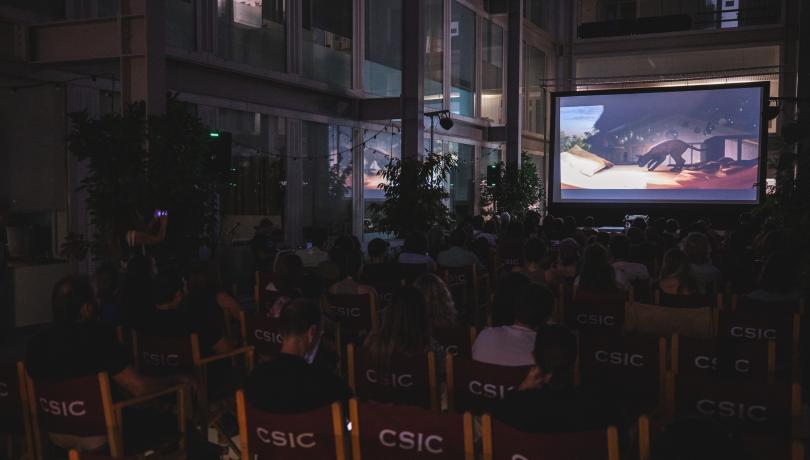In this month’s “In Depth” we talk about the multi-award-winning Flow, which we screened a few days ago at the ICM as part of the “CSIC de Cine” cycle, with a very enriching prior debate led by the institute’s researchers.

Some days ago, the Institut de Ciències del Mar (ICM-CSIC) hosted a new session of the “CSIC de Cine” cycle, an initiative that for three years has combined film screenings with scientific dialogues open to the public. The proposal has become a privileged way of linking research and culture, bringing science to the auditorium in a closer and more participatory manner. On this occasion, the chosen film was Flow, an animated movie that portrays a post-apocalyptic world where a cat and other animals join forces to survive. Its fantastic, tender, and at the same time unsettling story served as a starting point for a debate with Vanessa-Sarah Salvo, researcher at the ICM-CSIC and presenter of the event; Rafel Simó, also researcher at the ICM-CSIC; and Javier del Campo, from the Institute of Evolutionary Biology (UPF-CSIC).
Cooperation as a driving force of life
The debate began by questioning such a deeply rooted cliché as that of competition being the only driving force of evolution.
“In ecosystems there is competition, yes, but we cannot just stick to that part of the story,” warned Rafel Simó. For him, science and culture have tended to overvalue struggle and to forget that nature is full of examples of mutualism and symbiosis. From lichens to fish that clean other species, through plants that need fungi to grow, the message is clear: life thrives when there is collaboration.
Javier del Campo added an evolutionary perspective.
“Not everything is the struggle for life, cooperation is also a factor that helps us adapt,” he pointed out, recalling that coral reefs only exist thanks to the symbiosis between corals and microscopic algae. Adaptability, then, is not an anecdote, but an evolutionary driving force as powerful as competition. This idea connected directly with the plot of Flow, where the union of the animals stands as the only possible strategy in the face of adversity.
Interdependence and fragility
The dialogue also served to dismantle other myths. Simó warned that
“The one who is higher up in the food chain is often the first to fall.” Far from being the invincible “kings of the jungle,” large predators —such as sharks— are the most vulnerable to environmental impacts. Resilience, on the other hand, is found at the base of the ecological pyramid, where diversity and functional redundancy ensure the continuity of ecosystems.
The reflection on the fragility of predators led to an even broader idea: the interdependence of all forms of life.
“No living being is alone on the planet: we are all interdependent,” emphasized del Campo, who recalled that humans are holobionts, that is, organisms made up of ourselves and all the microorganisms that inhabit us. A reality that shows that the health of our species is closely linked to that of the planet.
“If we preserve the planet it is not for it, it is for our species,” del Campo concluded, aiming to add a layer of pragmatism.
At this point, the speakers provided examples of ecosystems’ capacity for regeneration: Mediterranean forests adapted to fire, Antarctic seabeds recovering after the passage of an iceberg, or the marine reserves of the Medes Islands. But they all agreed on a fundamental nuance: resilience depends on biodiversity. The disappearance of pollinators, for example, not only affects plants and animals, but can compromise our own food production.
“Biodiversity also protects us in terms of health,” underlined Simó, linking the loss of species with the growing risk of new pandemics.
When science dialogues with culture
The film Flow, with its cat protagonist and its emphasis on cooperation as a response to a devastated world, worked as a powerful metaphor for what science observes every day. Vanessa-Sarah Salvo highlighted the beauty of a story where the union of different species is key to moving forward. The audience, through cinema, could recognize in that symbolic tale the reality of ecosystems and, at the same time, a warning addressed to our own species.
The “CSIC de Cine” cycle demonstrates that culture can be a privileged space for science: a place where academic reflection mixes with emotion and critical thinking. And it is in this encounter that the message repeated in different ways by the three researchers gains strength: cooperation is not only an evolutionary strategy, but an urgent necessity for a shared future. Or, as Rafel Simó put it, “where I cannot reach, you may reach, and together we succeed better.”